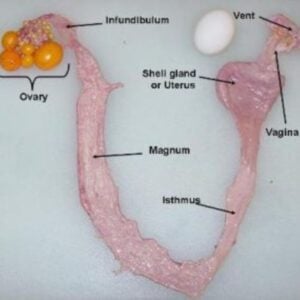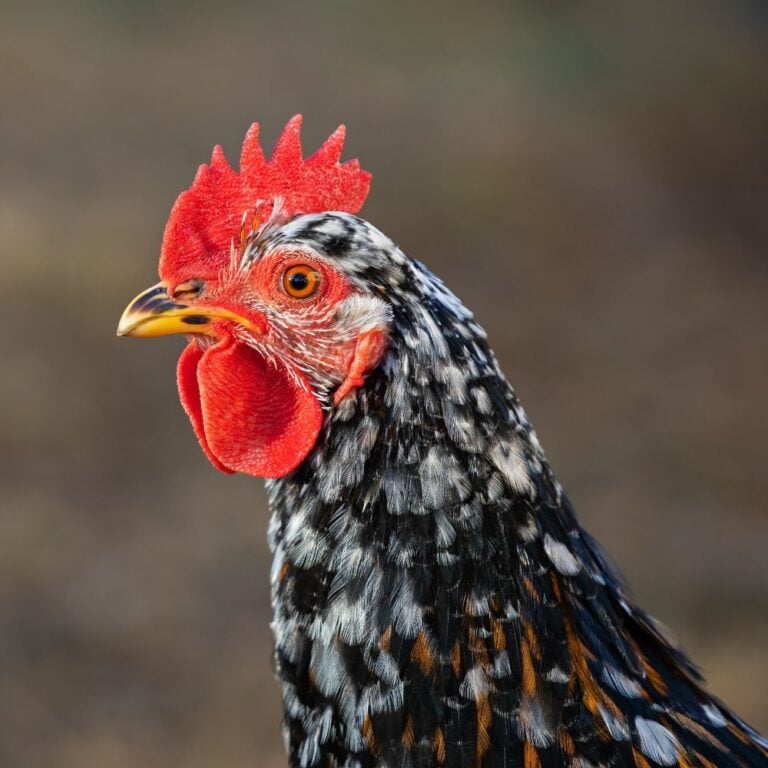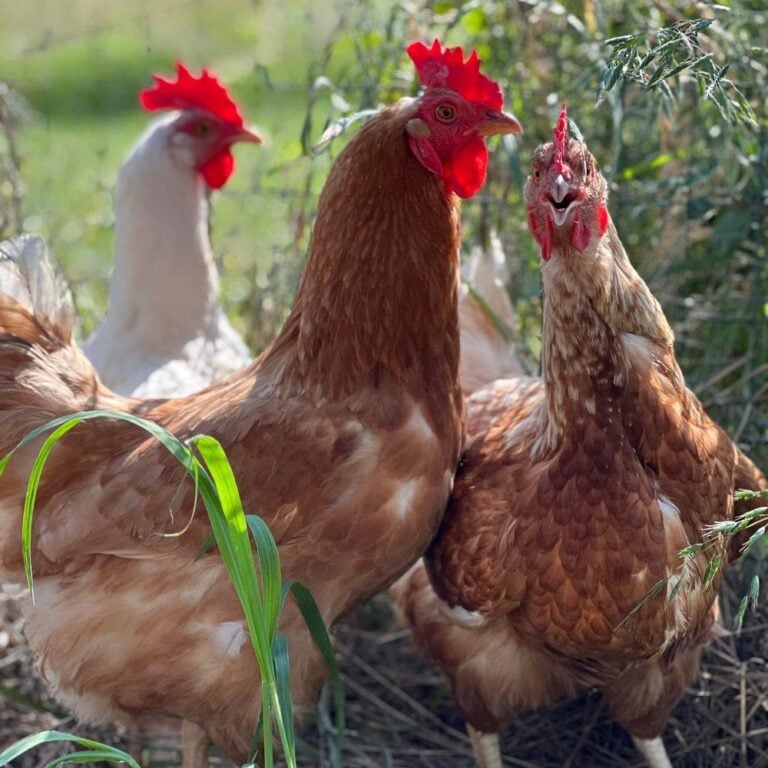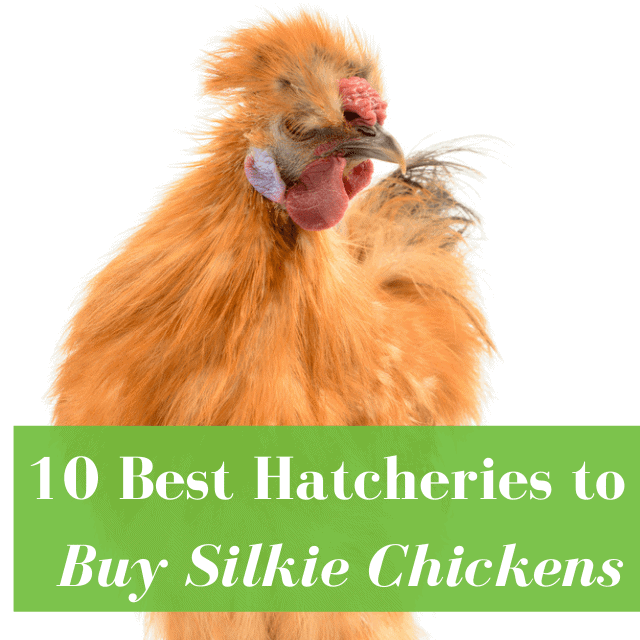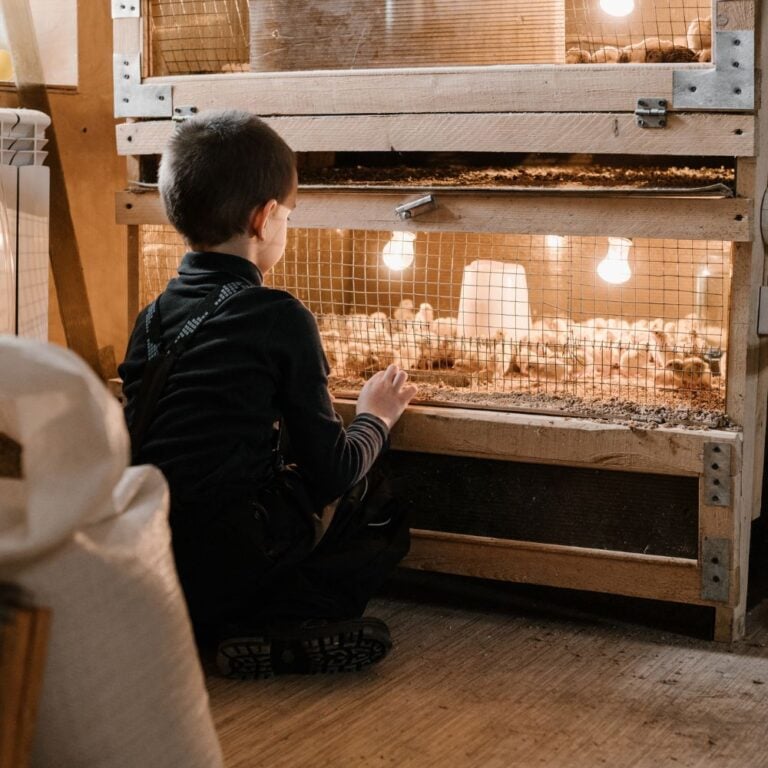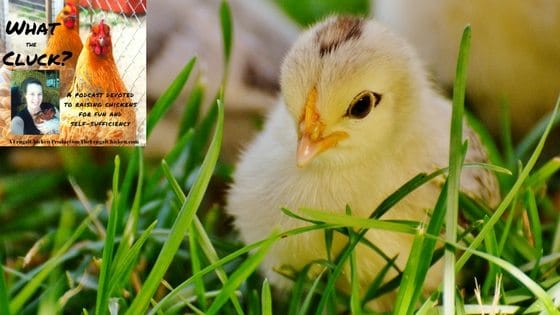A practical guide to learn all about how roosters fertilize chicken eggs, including interesting and surprising facts you never knew!
Table of Contents (Quickly Jump To Information)
The Birds (literally) and the Bees
If you have chickens, or are thinking of getting chickens, this age-old question has probably crossed your mind in one way or another. How do roosters fertilize chicken eggs?
The first thing to know is that you don’t HAVE to have a rooster for a hen to lay eggs, but you do have to have a rooster to make baby chicks. You may have already known this, but it’s not necessarily common knowledge…especially if you are city slicker (no offense). The second thing to know up front is that roosters don’t have a moral compass when it comes to romancing the flock. Keep reading to find out what I mean.
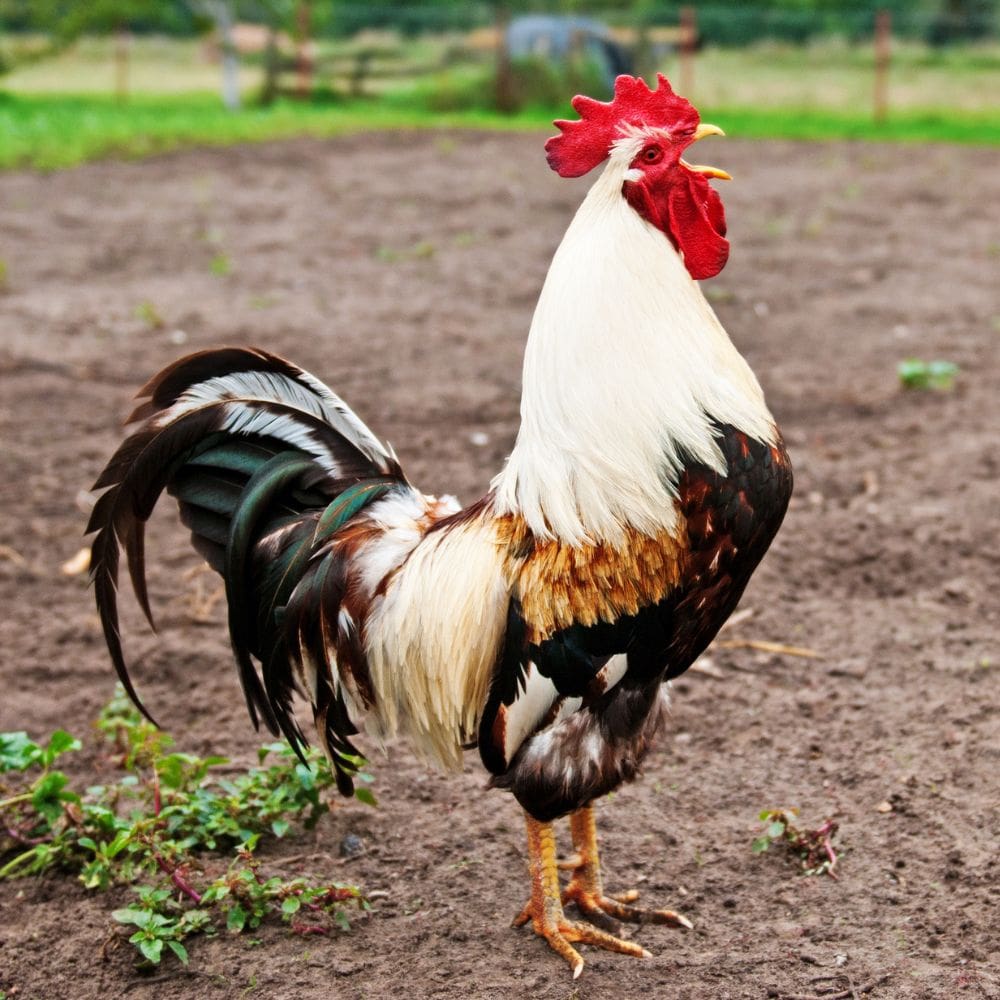
Do Chickens Get Pregnant?
Before you get out your best camera, dress up your favorite chicken, and set up a bed of flowers in the field in preparation for her first maternity photos, you better read on. Chickens do not get pregnant.
Their eggs go through a process of getting fertilized and then the hen lays the eggs. At that point, the incubation process can occur if all the right conditions and care take place. We will cover that briefly here in a bit. For now, just know that you might want to take cute chick pics instead of maternity photos.
What’s the Difference Between Roosters and Hens in Mating?
Well, it’s not too different from humans believe it or not. The rooster has two testes that develop. Once the rooster reaches sexual maturity it starts producing sperm and continues to do so. A hen, on the other hand, is born with two ovaries but only the left one fully develops and becomes viable. This falls into the category of weird but true, and it’s a little bit of a mystery.
A hen is born with the number of ova (eggs) it will have for its entire life. She will not produce more ova along the way. Her egg production is set from birth, no more and no less. I suppose her mother likely gives her some kind of advice like “You get what you get, and you don’t throw a fit.”
I did promise you would learn some surprising facts that you never knew, and I did I’m delivering just that! BUT there is more to come.
Rooster Reproductive Anatomy
Whether we like it or not, talking about the roosters reproductive anatomy is essential in order to understand the process of egg fertilization. Here is a list of need-to-know vocabulary and their meanings:
- Testes – produce sperm
- Vas deferens – the main area of sperm storage as well as the tube it travels through
- Cloaca – chamber just inside the vent, on a male it contains two tiny nipples (called papillae) that transport semen
- Papillae – the two tiny nipples that are the main mating organs of the rooster (they do not have a penis)
Hen Reproductive Anatomy
- Ovary – cluster of developing egg yolks (more on this in another section)
- Oviduct – a tube, that allows passage of eggs, that is attached to the hens back approximately half way between the neck and the tail. The oviduct is about 25 inches long and is a twisted tube. This crazy organ is quite intricate, here is the breakdown:
- Infundibulum – funnel that catches and channels the released eggs, the first layer of egg white is secreted
- Magnum – a large section where most of the white of the egg forms
- Isthmus – a narrow organ connecting two larger parts, where the inner and outer shell membranes are formed
- Shell gland – the uterus, the shell forms on the egg here
- Vagina (gulp…who knew a chicken had one?) – the muscle that pushes the egg out, the bloom (protective layer on the outside of the shell) forms here right before the “birth” of the egg
- Cloaca – a flap that helps keeps the vaginal tract and the intestinal tract separate
Fun fact: Near the meeting of the shell gland and the vagina are the sperm host glands. When an egg is laid it squeezes more sperm out, the sperm travels up the oviduct to the infundibulum – ready to fertilize another egg! This system works like a well oiled machine and makes it possible for eggs to be fertilized for up to 14 days (approximately 11 – 14 eggs) all from one mating! Wowzer, that could result in a lot of little chick babies!
Check out more about the avian reproductive system here.
The Rooster and Hen Dating and Mating Process – Egg Fertilization
Whenever I watch a movie, I take notice of just how much the background music affects my emotions. From time to time, I wonder how much more rich life would be if music was always in the background for the specific moment…dramatic music for intense happenings, peppy music when watching my goats hop from platform to platform, and so on.
But when it comes to a male chicken mating female chickens, I think I’d rather skip the musical interlude. Why? Because it’s a bit brutal if you ask me. In fact, I almost feel like calling the sheriff when I happen upon this process. I don’t think sweet, romantic music in surround sound would help. Just sayin’.
The Courtship Dance
So how does a rooster “court” a hen? He doesn’t exactly take her out to a top local restaurant, then square dancing, and finally to a dark room with nothing but candle light. Not all, but most, roosters will perform a special mating dance to impress the ladies.
It’s not the tango, but it’s pretty interesting to watch. The rooster will make a unique croaking kind of noise, stretch one of his wings stiffly toward the ground, while circling the hen. There are, of course, many variations of this dance. A rooster may also fan out his wings to show how macho he is. Mrs. Chicken may run away as fast as she can, or squat in an invitation to proceed.
Courtship Tidbitting
Another tactic in the roosters’ well-known bag of courtship tricks is called tidbitting. This is when the rooster randomly dances around, and bobs his head, and picks up and drops little bits of food or bugs for one of his ladies to come get.
I remember when one of our roosters did this and my daughter was telling me about it. We thought he was just a sweety taking care of his hens. Later to find out – it was all part of his mating ritual. It was his way to lure a hen to him for mating. Still, it’s a sweet way to do it even if it is a bit tricky. Again, the hen might accept the invitation by squatting or take the food and run if she’s not feeling especially romantic.
Mating Details (How roosters fertilize eggs)
If the hen doesn’t squat and/or decides to run, the rooster will usually chase her down anyway. Either way, he will hop on top of her, use his beak to hold her by the neck or feathers and start the mating process. They will press together, the male with his cloaca and the female with her vent opening (the female also has a cloaca but not the two “nipples” inside like the rooster does). This moment is called the “cloacal kiss.” The male will release the semen, the female accepts it, then it will travel up the oviduct to find an egg to fertilize. This is when the sperm joins the ova (egg) and fertilization occurs. And this is precisely how roosters fertilize eggs.
Fun facts:
- Hens can actually eject the sperm from her body if she chooses not to have a particular rooster fertilize her eggs.
- Chicken eggs can only be fertilized inside the hen BEFORE the shell is formed around it.
- This one is a doozy. Chickens don’t make a complete egg, then lay the egg, make another complete egg, then lay the egg – one egg at a time. They have something similar to a little factory.
- There is a little tiny yolk, a slightly bigger little yolk, a medium yolk, a bigger yolk, and so on….a whole chain of progressively bigger yolks all linked together with a membrane waiting in line to grow bigger, get the gift of the egg white, and then be “shelled.” It’s amazing! I found this out when butchering chickens with a friend who brought a hen she thought was done laying eggs (she was wrong…oops). This little yolk factory is the chicken ovary. I was AMAZED and told everyone I knew (you can imagine how everyone was just waiting to hear this news).
Mating Facts
- Roosters are most active in the mating arena in Spring time (love is in the air)
- Roosters are usually 4 to 5 months old when they become mature enough to start mating (pretty impressive)
- Roosters have favorite hens (sounds like a reality TV show in the making)
- Roosters can mate 10 to 20 times a day (they sure are persistent)
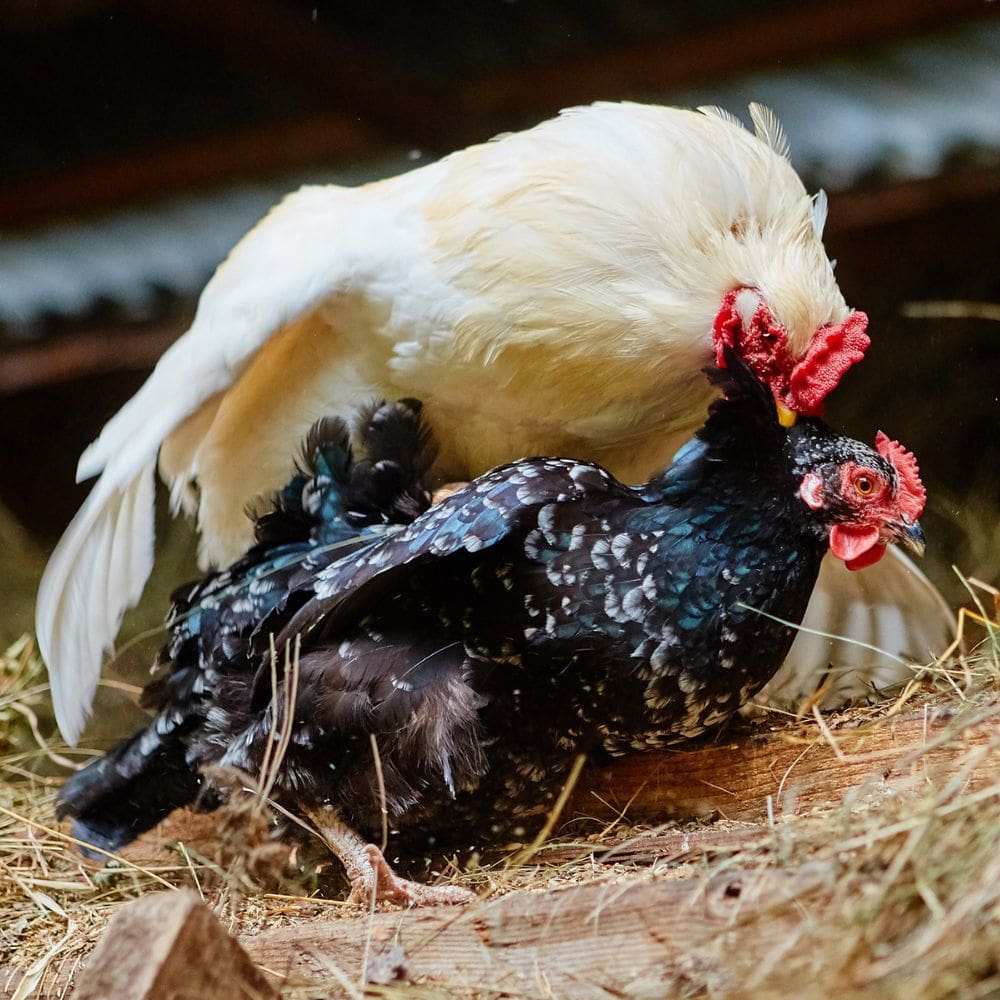
Friendly Warnings
Mating Can Be Scary for the Chicken Owner
A warning to you, if you’ve never seen the poultry mating process – it can be kind of scary. It often appears that the rooster is being forceful and even hurting the hen. I comfort myself by remembering this is how they were created and everything will be okay in the end. Many animals have similar mating techniques, it’s just the way it is. So, don’t be alarmed and prepare your children beforehand so it doesn’t scar them for life.
Your Hens Will Lose Feathers
Another thing to know is that your hens will lose some feathers on her back and neck. It’s not the prettiest sight to see, but just think of it as human stretch marks or extra belly fat – it’s all worth it for the babies! However, there can be a point at which the rooster has become TOO AGGRESSIVE or “over-mates” the hens. This can lead to open skin wounds which can then lead to fly strike. If your rooster becomes overwhelming to your hens it’s time to rehome or get out your chicken noodle soup recipe.
Some folks use a thing called a chicken saddle to help their hens out. A chicken saddle is a little garment that protects their back from the aggressive grip of the rooster during mating. I’ve never used one, but you might give it a try if you are feeling adventurous. As for me, I’ve never had much luck with dressing any farm animal with success.
If you have some hens that look ragged and featherless on the back, you might read this article we wrote for tips. You can also try some dietary supplements that have proven to be very helpful, check these out.
Roosters Mating Roosters
You will also want to keep an eye out for roosters “mating” roosters if you have several roosters. It’s a thing. It’s all about establishing dominance and pecking order. If this becomes a persistent problem, you may need to provide different flocks for each of them, or rehome one or more of them.
What’s the Difference Between Fertilized Eggs and Unfertilized Eggs?
When you crack a farm fresh egg open, provided there is a rooster or two around, you should be able to visibly see whether or not the egg is fertilized. If it’s fertilized you will see a tiny white spot on the top of the yolk (called a germinal disc). If you don’t see that, you can be pretty sure it’s not fertilized.
Some eggs, both store bought and farm fresh, will have a little red spot on the yolk. This does NOT mean that it is fertilized. This red spot is actually just what it appears to be, a spot of blood. It’s perfectly safe to eat eggs that have been fertilized and eggs that have a blood spot. If it panics your tender heart, you can simply scrape it off. No problem.
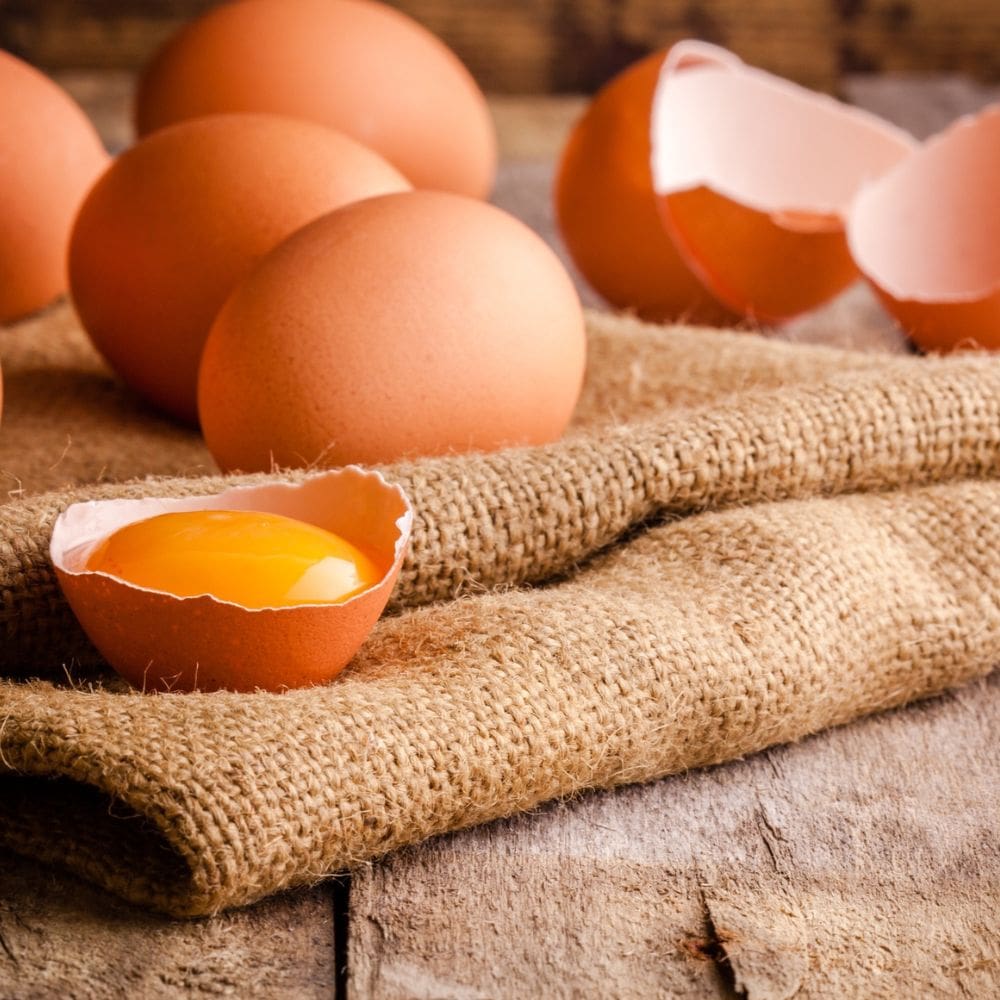
The Miracle of Chick Embryo Development
This process, as all new life, is truly a miracle in my estimation. The realization of this process being miraculous happened for me when I bought an incubator to incubate my own fertilized chicken eggs. Through that process, I came to understand just how much respect the mama hen deserves. As a sidenote, if you decide to let a hen go broody or if you decide to incubate your own eggs, be sure to keep those eggs healthy for the best experience.
Steps of Chick Development
Step 1: The egg is fertilized through the mating process and then laid about 24 hours later.
Step 2: The warmth of the hen’s body enables the embryo to start the beginning stages of development. Within just a couple of hours of fertilization there is a cell that splits into two, and then four, and then eight, and then sixteen, and so on.
Step 3: When the egg is laid, the temperature drops and the cell growth stops. However, it can be triggered again with warmer temperatures.
Step 4: Either a broody mother hen can sit on the eggs or you can incubate the eggs in an incubator.
Step 5: If all the proper conditions occur, chicks will start developing and growing, chicks will start hatching in 21 days (or sometimes longer if a mama hen is doing the incubating).
The entire process from day one of incubation all the way through to hatching is incredible. The temperature has to be just right, the eggs have to be turned every couple of hours for most of the days, and the humidity has to be controlled. There’s a lot to it, and the hen knows how to do it. But that’s a story for another blog.
References
- Live Science
- University of Oxford
- Merck Manual
- Penn State Extension
- Extension – A Part of the Cooperative Extension System
- Poultry Hub
- Mississippi State University Extension
- Science Buzz

A happy wife, mother, teacher, writer, hobby farmer, lover of chickens, and contributor to Pampered Chicken Mama!

